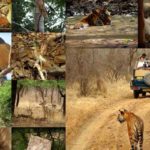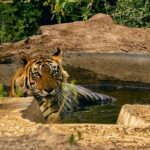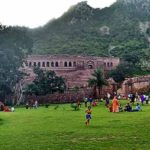Sariska Wildlife Sanctuary is amongst the most visited national parks of the country and is located in the Alwar area of Jaipur, Rajasthan. Situated around 107 kilometers far from Jaipur, this national park covers an unfathomable span of 800 sq. kilometers territory and is overseen by the Government of Rajasthan. The National Park is partitioned into segments of deciduous forests, fields, rough scenes, and steep precipices.
The Sariska National Park circles the ‘Siliserh Lake’ and the ‘Jai Samand Lake’, which are home to various crocodiles, water snakes and different creatures of land and water. In spite of the fact that there are very few tourist destinations around Sariska, the National Park serves as the untainted getaway for the tourists looking for peacefulness and endless spans of widely varied vegetation in Jaipur, Rajasthan.
The sanctuary also houses the ruins of ancient temples of Garh-Rajor that dates back to the 11th centuries. Also a 17th-century fort on the hilltop at Kankwari grants a picturesque view of soaring vultures and eagles. Sariska Wildlife Sanctuary is home to numerous carnivores including , Wild Dog, Jungle Cat, Hyena, Jackal, Leopard, and Tiger. These feed on an abundance of herbivorous species such as Sambar, Nilgai, Chausingha, Chital, Wild Boar and Langur.
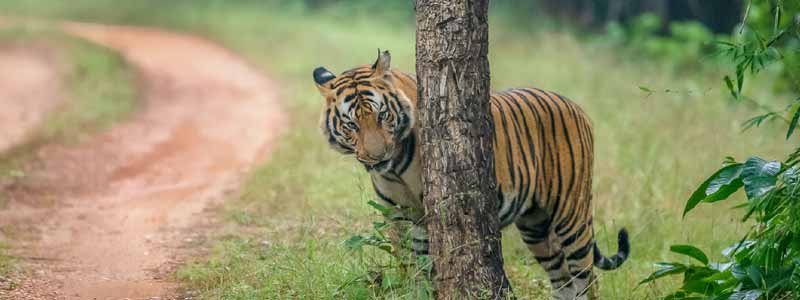
Quick Facts of the Sariska National Park, Alwar
- The total area of the sanctuary is about 800 square kilometer
- The total area for the national park is about 273.8 square kilometer
- Forest types found- tropical, dry, deciduous, and tropical thorn
- Altitude: between 300 meter and 722 meter MSL
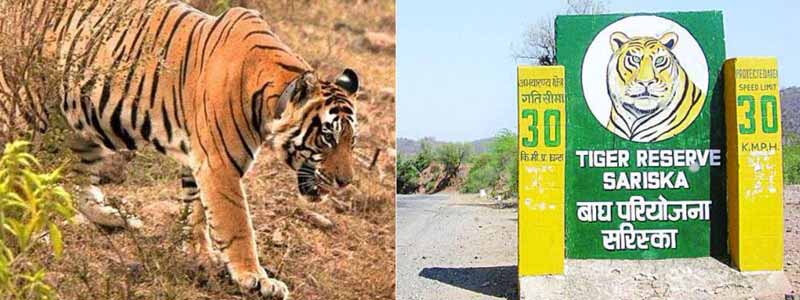
History of Sariska National Park
Sariska Wildlife Sanctuary in Alwar locale sees the inheritance of the Maharajas of Alwar since the vestiges of structure and sanctuaries of the then ages inside the Sariska zone bring the brilliance and lavishness of Rajputana period. The seventeenth exceptionally old Kankawadi Fort, at the focal point of the hold has a long and turbulent history. This post was being worked by Jai Singh II. The stronghold is being known for the detainment of Dara Shikoh by his sibling the Mughal Emperor Aurangzeb for the progression of the honored position.
The nearness of conspicuous sanctuaries really brings incredible traffic making a few issues to the untamed life albeit, yet at the same time they are extremely noteworthy. The focal point of Sariska Tour Packages is additionally being renowned for Pandupol, one of the retreats of Pandavas and the well known Hanuman sanctuary is the purpose behind the most loved journey site. Altogether, the Nilkanth sanctuary worked by the Barjgujars and the Bhartihari sanctuary is additionally being packed with numerous explorers every now and again. The Neelkanth or Rajor Gath was the capital of Bargujars and Raja Bhartihari, the leader of Ujjain intervened at the Bhartihari sanctuary.
Aside from that Sariska Wildlife Sanctuary is additionally eminent for Tal Briksh, the boiling water spring and numerous regal structures including the Sariska Palace, which was utilized as the imperial chasing hotel of Maharaja jay Singh.
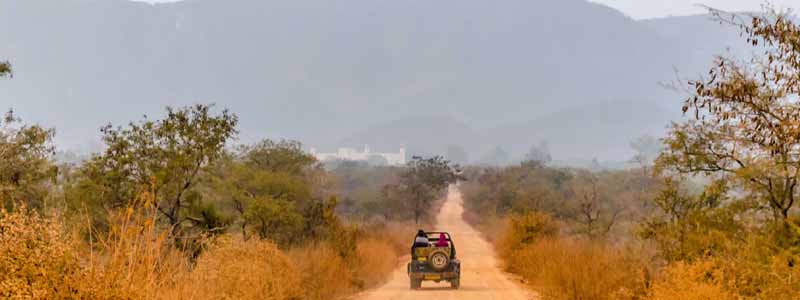
Terrain
The terrain of Sariska Wildlife Sanctuary is hilly with numerous valleys, both wide and narrow, and expansive undulating plateaus. The characteristic features of the Aravalli range – sharp hog -black ridges – are conspicuous in the Reserve. Most of the high ridges are composed of quartzite conglomerates and grits.
Flora
The forests are of a typical dry deciduous type with Dhok as the dominant tree species of gentle to moderate slopes constituting over 90% of the tree canopy. The ridges support Salar on steep dry slopes. Khair and Cheela occur in vally beds. Bamboo grows to a limited extent along moist and cooler parts. Aam, Jamun, Arjun and Bahera, which grow in moist depression and on nallah banks attain large sizes. The ground cover is mainly Ber, and Adusa. Zizyphus and Grewia are good fodder species. The dried and fallen leaves of Dhok help the herbivores to tide over the fodder scarcity during summer months. The forests become lush green in the monsoon months and completely dry in the summer months.
Fauna
Sariska is very rich in wild animals. Panther, Hyena, Jackal and Jungle cat are the carnivores of the forest. Caracal and Wild dog are seen very rarely. Among the prey population are the Sambhar, Chital, Nilgai, Wild boar, Hare and Porcupine etc. Sariska is unique in animal distribution. The wild animals here seem to have decided their area -limits. Slopka is best for observing the Sambhar, Kundli for Chitals and Tarunda & Kalighati for Nilgai. Four -horned antelopes or chausingha can be seen in the Pondupole Nallah. Chausingha is exclusively Indian and is the only buck on earth with four horns.
Sariska Wildlife Sanctuary is also famous for its population of common Langurs and the Rhesus monkeys. Talviksh is where the main population of Rhesus exists and one can see hundreds of them at a time. Langurs can be seen in large numbers at Pandupole, slopka and Kalighati as well.
In sariska, observing Wildlife at the water holes is quite fascinating during the hot days of April, May and June. Water requirements increase and Wildlife activities get restricted to the water holes,specially around Kalighati and Slopaka. Sambars, Chitals, Nilgais, Chausinghas, Jackals, Wild boars, Langurs etc. visit water holes throughout the day. The predators appear around dusk or during the silence of the night.
Birds
For the ornithologists and birding enthusiasts, the natural surroundings of Sariska draw the migratory birds from Siberia and China. It is quite a mingling of horned owl, tree pie, grey partridge, woodpecker, peafowl, crested serpent eagle, bush quail, sand grouse. Probably, Sariska is the richest Tiger Reserve as far as avifauna is concerned. More than 225 species of birds can be seen here. The populations of Peafowl, Grey partridges and Bush quail are conspicuous. Other commonly seen birds are Parakeets, Red spurfowl, Doves Green pigeon, Flycatchers, Bee-eaters, Shrikes, Woodpeckers Vultures and Nightjars etc.
Trees Checklist of Sariska
Dhok (Anogeissus pendula) is the dominanat tree species covering over 90 per cent area of the forest. Boswellia serreta and Lannea cormandalica grow at rocky patches. Kattha (Acacia catechu) and Bamboo are common in the valleys. Some valleys support Palas (Butea monosperma) and Ber (Zizyphus spp.). Besides these, some noteworthy tree species are Arjun (Terminalia arjuna), gugul (Commiphora wightii), Kadaya (Sterculia urens), Amla (Emblica officinalis), Bahera (Terminalia belerica).
Best Time To Visit Sariska Wildlife Sanctuary
The best time to visit this protected area is from October until May, due to the colder temperature and a pleasant weather. However, the best time to spot tigers in Sariska Tiger Reserve is in the summer months, when they move in search of waterholes in the absence of much foliage to camouflage themselves.
Keep in mind that during the summer months, the weather is extremely humid and hot. Also, the park remains closed between 1st July and 30th September. It is also closed on major national holidays Sariska Wildlife Sanctuary.
How To Reach Sariska Wildlife Sanctuary
Sariska Wildlife Sanctuary lies 106 km away from Hindaun, 107 km from Jaipur and 200 km from Delhi. Sariska is well connected to Alwar, which is directly connected to NH-8. The buses from Alwar to Sariska are available on a regular basis. The nearest railway head is that of Alwar (at a distance of 37 km), and Jaipur is the nearest airport (at an approximate distance of 107 km). The tiger reserve lies on the Delhi-Alwar-Jaipur Highway.
Air : The nearest airport to Sariska National Park is ‘Jaipur Sanganer Airport’ situated at a distance of 110 km facilitates easy access by air.
Rail : Alwar Railway Station’ is the nearest railhead to Sariska Wildlife Sanctuary. The railway station which is situated at a distance of 38 km from Sariska connects all major tourist destinations and important cities of India like Jaipur, Delhi, Kolkata, Indore,Mumbai, Kota and many more by rail.
Bus : Sariska National Park is well connected by road and buses operate by the Rajasthan State Road Transport Corporation (RSRTC) and other private operators in the area and to all the cities of the state and the country.



